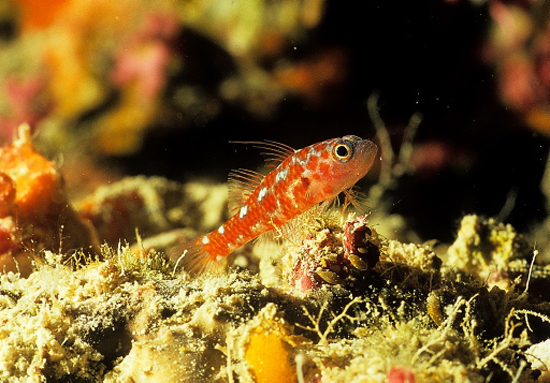| Gobiidae (Gobies), subfamily: Gobiinae |
| 3.5 cm SL (male/unsexed) |
|
reef-associated; marine; depth range 3 - 30 m |
| Indo-West Pacific: Seychelles, Aldabra, Chagos Islands, Ryukyu Islands, and Loyalty Islands; Mariana and Marshall islands in Micronesia. |
|
Dorsal spines (total): 7-7; Dorsal soft rays (total): 7-8; Anal spines: 1-1; Anal soft rays: 7-9. Diagnosis: a frontal ridge behind the orbits that slopes steeply into a wide interorbital trench
anteromedially, and into postorbital trenches laterally; posterior nasal opening separate from eye; second spine of first dorsal fin elongate, third spine occasionally elongate; fifth pelvic fin ray branched once dichotomously; body color orange-red with seven dorsolateral white spots
between posterodorsal margin of the peduncle and origin of first dorsal, and with four ventrolateral spots between posteroventral margin of peduncle and origin of last anal ray; facial pattern uniform dusky orange-grey colour under orbit, with an orange vertical blotch, edged in melanophores on vertical limb of the preopercle resembling a club; conspicuous bar of melanophores extending vertically across posterior margin of pectoral base (Ref. 57688). |
| Occurs in lagoons and seaward reefs; on rubble and reef rock (Ref. 1602); also over coral patches interspaced with fine sandy bottoms, occasionally form small schools (Ref. 37688). Feeds on copepods, ostracods, and radiolarians (Ref. 1602). |
|
Least Concern (LC); Date assessed: 21 June 2017 Ref. (130435)
|
| harmless |
Source and more info: www.fishbase.org. For personal, classroom, and other internal use only. Not for publication.

